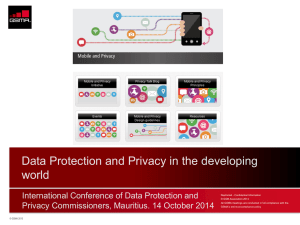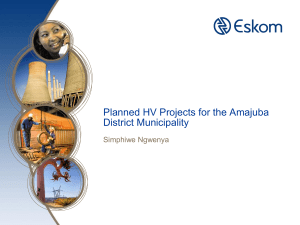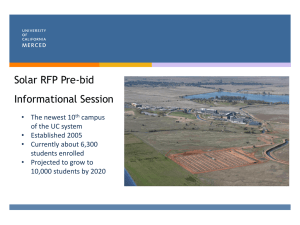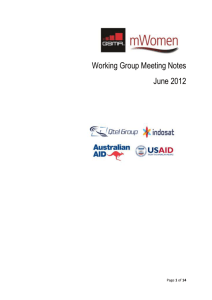PicoSDLA-CH 4 - Copernicus.org
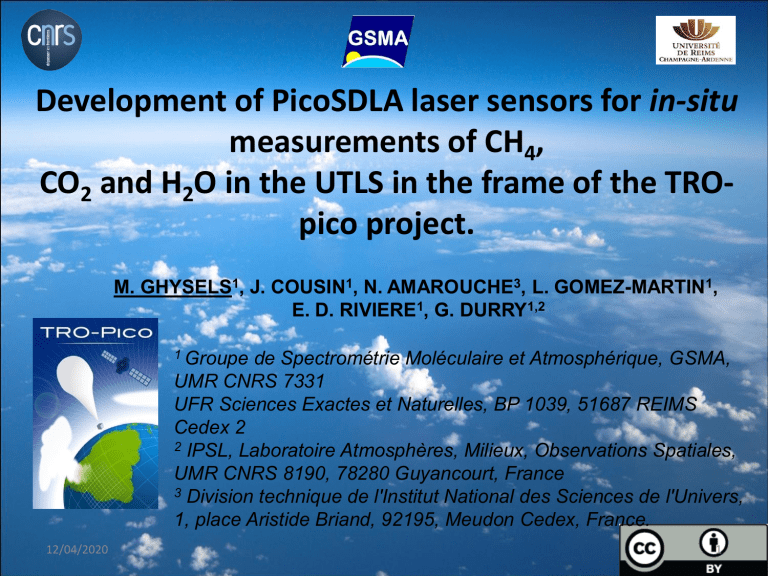
Development of PicoSDLA laser sensors for in-situ
CO
2
measurements of CH
4
, and H
2
O in the UTLS in the frame of the TROpico project.
12/04/2020
M. GHYSELS 1 , J. COUSIN 1 , N. AMAROUCHE 3 , L. GOMEZ-MARTIN 1 ,
E. D. RIVIERE 1 , G. DURRY 1,2
1 Groupe de Spectrométrie Moléculaire et Atmosphérique, GSMA,
UMR CNRS 7331
UFR Sciences Exactes et Naturelles, BP 1039, 51687 REIMS
2
Cedex 2
IPSL, Laboratoire Atmosphères, Milieux, Observations Spatiales,
3
UMR CNRS 8190, 78280 Guyancourt, France
Division technique de l'Institut National des Sciences de l'Univers,
1, place Aristide Briand, 92195, Meudon Cedex, France.
1
Scientific context
+ 150%
Sources of methane:
• Anthropogenic : Fossils fuels production, rice cultivation, biomass burning, waste management, etc…
• Natural : Wetland, non-wetland soil, gas hydrates, premafrost, termites, oceans, etc…
More than 50% of methane emission come from humanrelated activities
On per molecule basis, 25 times more efficient radiatively than CO
2 molecule
12/04/2020 M. GHYSELS, GSMA 2
Water vapor and methane in the stratosphere
O3 depletion during winter 2011
In the tropics : Deep convection permits injection of species in the stratosphere by overshooting convection or slow ascent in the
TTL
Oxidation of CH
4 in stratosphere:
CH
4
+ OH CH
3
+ H
2
O
Methane in stratosphere: source of water vapor
Winter at poles: In the stratosphere, PSC formation → Ozone depletion
12/04/2020 M. GHYSELS, GSMA 3
TRO-Pico balloon campaign
(PI. E. D. Rivière, GSMA)
Main Objective : Characterization of overshoots in order to quantify their impact on the hydratation of low stratosphere
(regional → global scale)
•Cirrus formation, impact of electrically charged particules on
TTL
•Validation of satellites measurements of water vapour of
IASI/Metop and SAPHIR/Megha-tropiques
•Variability of low stratosphere humidity : regular sounding of water vapour
Launchs from Bauru (Brazil, 22 °S)
Collaboration: l’IPMet-UNESP
12/04/2020 M. GHYSELS, GSMA 4
Development of PicoSDLA-CH
4
scientific objectives
:
PicoSDLA-CH
4
~15 kg : L= 3.6 m
SDLA [Durry and G. Megie, (1999)]
Total weight ~80 kg, L = 56m
PicoSDLA-CH
4
:
• Precision <5%
• Measurement time reduced:
10 ms to 1 s (measurement under parachutes, speed ≈ 15 m.s
-1 )
• Regular soundings under small meteorological balloons
12/04/2020
PicoSDLA-CH
4 optical path lenght :
3.6 m
M. GHYSELS, GSMA
SDLA spectrometer, optical path lenght : 56m
5
Based on direct absorption spectroscopy :
F
0
F
Laser Détector
Determination of mixing ratio from Beer-Lambert law :
(low absorption hypothesis)
A mol
(
)
F
F
0
S ( T atmos
)
( T atmos
, P atmos
,
)
L
N
CH 4
S(T atmos)
: Line strenght [cm -1 /molec cm -2 ]
φ(T atmos
, P atmos
, σ) : Line profile
L : Optical path lenght [cm]
N
CH4
: Number of molecules
12/04/2020 M. GHYSELS, GSMA 6
CDFG
Laser module
Optical fiber
1.5 µm
Signal diode
PPLN crystal
Pump diode
1 µm
Output power ≈ 10µW
Continuous coverage: 3076 to 3096 cm -1
3.24 µm
Laser head
Novawave Technologies
(Dr. J. JOST), Inc. (USA)
20 cm x 12 cm x 2.5 cm,
980g
DFG laser source → access to the R(6) transition of the ν
3 of CH
4
(3086 cm -1 , 3.24 µm) band
Strong fundamental band → Reduction of optical path lenght: 56m → 3.6 m
In laboratory, determination of spectroscopic parameter
(uncertainty <2%)
12/04/2020 M. GHYSELS, GSMA 7
PicoSDLA-CH
4
sensor
Gold coating retroreflector
M. GHYSELS, GSMA
Laser head
Detector
Germanium filter
8 12/04/2020
2 balloon campaigns:
• ENRICHED, Kiruna 2011.
Successfull test flight the 1 st of April inside the polar vortex
ComparisonTWIN/ PicoSDLA
→ good agreement
Precision : 5% at 20km
1. 10 -3
PicoSDLA-CH
4 onboard TWIN
(PI A. Engels, University of Frankfurt)
LOD 2. 10 -4
M. Ghysels et al, Ap. Phys. B,104, Issue 4 (2011), Page 989-
1000.
12/04/2020 M. GHYSELS, GSMA
Kiruna
9
TRO-Pico Bauru (Brazil, 22 °S) 1 scientific flight
14 th of March 2012
Preliminary results :
Temperature (°C)
CH4, R(6) manifold,
-80 -60 -40
ν
3 band, Alt: 22.6 km
-20 0 20
1,000
PicoSDLA-CH
4 before flight
(Bauru, 2012)
12/04/2020
0,998
100
0,996
PicoSDLA-CH
4
14 th flight of March 2012 (Bauru)
0,992
ρ
CH4
= 1.42 ± 0.05 ppmv
Temperature
3085,8 3085,9 3086,0
Pico-SDLA CH ascent
-1
)
1000
1,4 1,5 1,6 1,7
Mixing ratio (ppmv)
M. GHYSELS, GSMA
Observed
Calculated
3086,1 3086,2
1,8 1,9
10
Sensor PicoSDLA-H
2
O
1 m path lenght, 10kg weight
TRO-Pico : 3 flights (march 2012)
ENRICHED (2011): comparison with
ELHYSA (PI. G. Berthet, LPC2E, Orléans)
→ good agreement
Date of the flight
9 th of March
11 th of March
13 th of March
12/04/2020
Remarks
Need more work for data process
Successfull, overshooting?
Sucessfull, convective conditions during the flight. Need more analysis
M. GHYSELS, GSMA
1m
PicoSDLA-H
2
O , Bauru 2012
11
13 th March 2012
40
Preliminary results
-80 -70
Temperature (°C)
-60 -50 -40 -30
11 th
of March
13 th
of March
60
80
100
120
140
160
180
200
1E-6
M. GHYSELS, GSMA
1E-5
Mixing ratio
Signature of overshoots ?
12 12/04/2020
PicoSDLA-CO
2
Calibration in laboratory:
• Long time measurements (4h) from calibrated mixing of carbon dioxide and dry air
• Allan variance : τ
Allan
= 980 s, σ
Allan
= 280 ppbv
Precision ≈ 1ppmv for 1s averaging time
Calibrated value : 503.9 ppmv
Calculated value : (502.6 ± 2.2) ppmv
4h
M. GHYSELS, GSMA 12/04/2020 13
PicoSDLA-CO
2
flights
Objective : Lack of observations of the CO
2 concentration’s decrease throught the UTLS [S. Park et al.
(2010)]
About ≈ 10 ppmv (mid-latitudes)
•ENRICHED balloon campaign from
Kiruna (67 °N) : 1 flight the12 th of
March 2011
•Shortly : TRO-Pico balloon campaign from Bauru (22 °S), 2 flights
12/04/2020 M. GHYSELS, GSMA 14
Conclusion
ENRICHED :
Intercomparison TWIN/ PicoSDLA-CH
4
Intensities (uncertainty <2%), γ self
→ good agreement determined
Actually, temperature dependance of γ air
Validation of PicoSDLA-H
2
O by intercomparison
ELHYSA/PicoSDLA
Test flight of PicoSDLA-CO
2
TRO-Pico :
PicoSDLA-CH
4
: 1 flights and 1 future flight (Jan-Feb of 2013).
PicoSDLA-H
2
O : 3 flights, 2 flights in convective conditions future: 15 background flights and 4 convective flights
PicoSDLA-CO
2
: 2 flights (in convective conditions)
12/04/2020 M. GHYSELS, GSMA 15
Thank you for attention
12/04/2020 M. GHYSELS, GSMA 16
